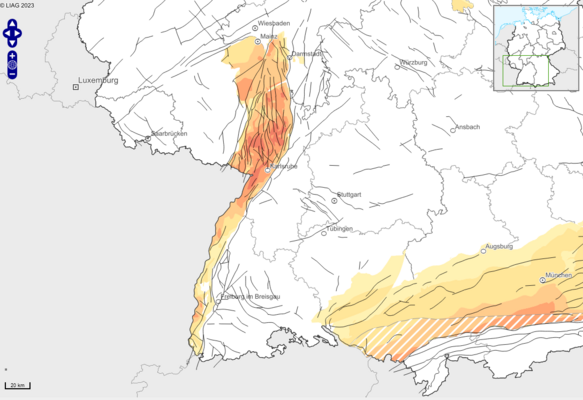Geothermal energy in the Upper Rhine Graben
The Upper Rhine Graben is one of three regions in Germany where the potential of geothermal energy has already been proven, and where geothermal plants are in operation.
Stretching from Riehen in Switzerland in the far south to Bruchsal and Landau, six plants are making use of a geological anomaly that provides particularly hot deep water at comparatively shallow depths. In addition to this enormous heat potential, the Upper Rhine Graben is also known for its seismic potential, which results from the numerous large fracture zones in the subsurface and the ongoing stress build-up.
The geothermal plant in Landau
Landau, located around 50 kilometers from Kaiserslautern in the Upper Rhine Graben, is home to one of Germany’s pioneering private-sector geothermal projects, which has been in operation since 2007. In addition to generating electricity from the first geothermal power plant, it also provided renewable heat to the town, an effort that is now to be expanded further.
The first borehole produced deep water at a rate of 60 liters per second at a temperature of 159 degrees Celsius. For the second borehole, with the knowledge of the authorities, the well was stimulated for a week with high water pressure, i.e. smaller fracture zones in the subsurface were widened. This process did not result in any significant seismic activity. However, during the first year of operation, the injection pressure increased sharply and led to seismic events with magnitudes of 2.7 and 2.4 in 2009. As a result, numerous reports of damage were filed, mostly concerning plaster cracks in buildings. Subsequent investigations were able to rule out geothermal energy as the cause in most cases. At the time of the first damage reports, the operator had not yet taken out liability insurance, something that is now standard for every geothermal project. In addition, an amendment to the Federal Mining Act introduced the principle of reversal of evidence, meaning the operator of the power plant must prove that the reported damage was not caused by him. On the technical side, injection pressure was reduced to mitigate the issue which curbed energy production. However, the originally planned second injection well was never drilled.
Another long-term point of criticism is the plant's high noise level. This is explained by the fact that, at the time of its construction, only minimal noise protection requirements applied due to the distance from residential areas. As a result, for example, no enclosure was installed around the above-ground motor of the feed pump.
In 2014, the company also faced challenges with leaks, but these could be rectified. Due to insufficient cementation in the uppermost piping area, leaking deep water led to ground heave and damage, including to a railroad line. This has since been rectified.
Despite the various challenges mentioned, geothermal energy has been officially pursued again in Landau since 2023 and the construction of a new plant is now in the planning stages. The lessonslearned from experiences have helped shaped the industry, leading to numerous advancements. Kaiserslautern can now also benefit from this wealth of experience.
Landau vs. Kaiserslautern

Unlike Landau, Kaiserslautern is not located in the Upper Rhine Graben but in the Pfälzer Mulde. This region has a lower natural stress field here, which significantly reduces the risk of seismic events. Additionally, the drilling target is different: we are planning to tap into a naturally water-bearing sandstone layer in the Rotliegend formation for hydrothermal geothermal energy.
Furthermore, the project in Kaiserslautern focuses on heat supply rather than electricity generation. Our goal is to provide a long-term, sustainable, and regional heat source for the citizens of Kaiserslautern.

